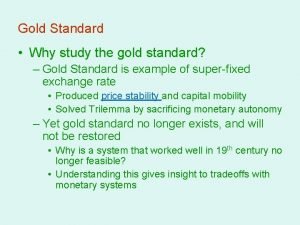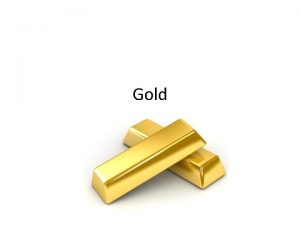Gold Standard The gold standard was a commitment
















- Slides: 16

Gold Standard § The gold standard was a commitment between participating countries to fix prices of their domestic currencies in terms of a specified amount of gold. § Money can be freely converted into gold at the fixed price. § Gold standard can be internal – anyone can demand conversion of currency into gold, or external – only central bank. § Central banks were required to hold reserves in gold.

Gold Standard Monetary authorities must obey the following 3 rules: § § § Fix once for all conversion rate of money into gold. There must be free flows of gold between countries on gold standard. Money supply must be tied to amount of gold monetary authorities have in reserve. § Central Banks were supposed to play by the rules of the game. § They were supposed to increase interest rates to speed a gold inflow (surplus) and reduce rates to ease an outflow (deficit). § But it hits domestic goals – for ex. Reduce unemployment.

Gold Standard § In 1834, US fixed price of gold at $20. 67 per ounce, where it remained until 1933. § The gold standard regulated the quantity and growth rate of a country’s money supply. § New production added only a little to accumulated stock. So the GS ensured that money supply and hence price level would not vary much. § However, periodic surges in world gold stock, ex. Gold discoveries in Australia and California in 1850, would make price levels very unstable in the short run. § As exchange rates were fixed, price levels around the world moved together – because of the automatic balance of payments adjustment process, called the price-specieflow mechanism.

Gold Standard § Ex: Innovation brings about faster real economic growth in the US. With supply of money (gold) essentially fixed in the short-run, U. S. prices fell. So prices of US exports fell relative to prices of US imports. So British demand more exports and Americans demand less imports. So, US BOP surplus is created. So gold (specie) flows from UK to US. Gold inflow increases US money supply, reversing initial fall in prices. In UK, money supply reduced, thus reducing prices. Net result is balanced prices amongst countries. § However, this also led to a shock in one country being transmitted to another country. § This happened in California at the time of gold discovery in 1848.

Gold Standard § Central Banks were supposed to play by the rules of the game. § They were supposed to increase interest rates to speed a gold inflow and reduce rates to ease an outflow. Effects: § Central banks cannot significantly alter money supply. So inflation remains under check. § If all countries use gold standard, there is effectively one currency in the world, i. e. gold. So, it provides stability to world markets.

Gold Standard Drawbacks: § However, stability is also a major drawback. Exchange rates are not allowed to respond to changing circumstances in the country. § It severely limits the stabilization measures of the central bank. During the Great Depression, the gold standard was finally abandoned. §

Bretton Woods System Came into force post World War II. IMF and World Bank formed. Features: § § The US govt. undertook to convert the US dollar freely into gold at a fixed parity of $ 35 per ounce. Other member countries of the IMF agreed to fix the parities of their currencies vis-a-vis the dollar, with a variation of 1% on either side being permissible. If exchange rate hit either of the limits, the monetary authorities were obliged to correct the situation by buying/selling dollars, as necessary.

Bretton Woods System § Thus, this was an adjustable peg system. The novel feature was that the parity of a currency against the dollar could be changed in case there was a fundamental disequilibrium. + - 10% was allowed even without the consent of the fund. § However, US had no flexibility. § Suppose Rs. 100 = 1 USD. So allowable limit is 99 and 101. Say demand for dollars increases due to Indians preferring American goods. So exchange rate will become 102. This is outside limits. So RBI will have to sell dollars. § Under this system, in effect the USD became international currency. Other countries accumulated and held USD by which they could settle international obligations. This could work so long as the world had confidence in the stability of USD and the ability of US treasury to convert dollars into gold on demand at the specified rate.

Bretton Woods System § However, problems started surfacing in the 70 s, when US BOP deficits started increasing. This reduced US gold reserves, reducing confidence in its ability to redeem dollars in gold. On 15 th Aug. 1971, the US Govt. finally abandoned its commitment to convert dollars in gold and the system came to an end. What do we use today? § We use the fiat system which says “money is intrinsically useless. It is used only as a medium of exchange”. Prices of gold are allowed to fluctuate as per demand supply.

Fixed and Flexible Exchange Rate System Merits of fixed exchange rates: § Transparent and simple: A fixed exchange regime is considered to be more transparent and simple anchor for monetary policy. § Suitable for countries with less developed financial sector: In a country with less developed financial sector and weak institutions, monetary stability can be achieved by anchoring to a currency with a credible central bank. The economic agents in such an economy may not have the financial tools to hedge long term currency risks. § Provides necessary stability for developing economies: Suitable for developing economies as it provides the necessary stability to implement the plans for economic development. § Helps smooth international borrowing and lending: As it provides certainty in the minds of foreign investors.

Fixed and Flexible Exchange Rate System § Promotes foreign trade: Removes uncertainty in foreign exchange transactions and helps importers and exporters to chalk out their policies in a better way. § Check on speculative tendencies: As the exchange rate is fixed, unnecessary speculation in the forex markets, which can be quite harmful to international trade, is avoided. § Reduction in transaction costs: As exchange risk is avoided, transaction costs involved in hedging are also avoided.

Fixed and Flexible Exchange Rate System Demerits of fixed exchange rate: Volatility in money supply: To maintain exchange stability, it is necessary to persue a policy of monetary expansion and contraction, wherever necessary. This can create serious volatility on domestic incomes and price levels. Also, adjustments under fixed exchange rates can be very gradual and require significant flexibility in domestic prices, especially in the face of changing capital flows. Constraints on monetary policy: In the process of taking monetary measures to maintain exchange stability, domestic goals which could otherwise be effectively pursued with the help of the monetary policy may have to be sacrificed. This may also involve a political cost. Independent economic policies not possible

Fixed and Flexible Exchange Rate System § Interest rate differences could influence capital flows: If interest rates in the domestic economy are higher that of the economy of the anchor currency, it could lead to huge capital flows from the foreign economy to the domestic economy, creating excessive money supply and resulting in inflation. Also, any adjustment in exchange rates could seriously influence capital flows, resulting in jolts in domestic money supply. § Capital Controls: To withstand currency pressures, authorities may have to put in place rigorous capital controls, which may prove to be harmful to the domestic economy. § Difficult to correct disequilibrium in the BOP position: Disequilibrium in the BOP position of a country can get corrected by suitable changes in the exchange rate. However, this is hampered in the fixed exchange rate system. § A country cannot maintain fixed exchange rate, open capital market and monetary policy independence at the same time.

Fixed and Flexible Exchange Rate System Merits of the flexible exchange rate system: § Independence in monetary policy: A floating exchange rate system allows a country to pursue independence in monetary policy, rather than have its own monetary policy set up by an anchor currency country. This can help in maintaining internal stability. § Reduction in shocks in money supply: Under a flexible exchange rate system, exchange rates are market determined. Any arbitrage opportunity that exists due to diverse variables in two countries (for example interest rates) tends to get absorbed by the market immediately. This reduces sudden shocks in money supply. § Automatic equilibrium in BOP: § Shock absorbing mechanism: Flexible exchange rate systems are more resilient in the face of shocks and are better able to distribute the burden of adjustment between the external sector and the domestic economy.

Fixed and Flexible Exchange Rate System Demerits of the floating rate system: § Economy exposed to external events: Under this system, the economy is exposed to external events as such events could have an impact on exchange rates and consequently international trade, BOP, etc. This hinders economic stability. § Uncertainties for importers and exporters: If suitable hedging tools are not available, it could seriously hamper business. § Speculation: Floating exchange rate encourages speculation. This may lead to hoarding of currencies, leading to many undesirable effects such as reducing money supply, inflation, etc. § Uncertainty in international lending: Problem for countries which need capital very badly.

Fixed and Flexible Exchange Rate System To conclude, one can say that there is probably no universally optimal regime. Regime choices should reflect the individual properties and characteristics of an economy. In a pure fixed exchange rate regime, economic activity adjusts to exchange rate. In a purely floating regime, the exchange rate is a reflection of economic activity. In either case, the economy’s fundamentals are the chief determinants of whether economic stability and prosperity are achieved.
 Công thức tính độ biến thiên đông lượng
Công thức tính độ biến thiên đông lượng Tỉ lệ cơ thể trẻ em
Tỉ lệ cơ thể trẻ em Thế nào là mạng điện lắp đặt kiểu nổi
Thế nào là mạng điện lắp đặt kiểu nổi Lời thề hippocrates
Lời thề hippocrates Vẽ hình chiếu đứng bằng cạnh của vật thể
Vẽ hình chiếu đứng bằng cạnh của vật thể Phản ứng thế ankan
Phản ứng thế ankan Quá trình desamine hóa có thể tạo ra
Quá trình desamine hóa có thể tạo ra Các môn thể thao bắt đầu bằng tiếng nhảy
Các môn thể thao bắt đầu bằng tiếng nhảy Hình ảnh bộ gõ cơ thể búng tay
Hình ảnh bộ gõ cơ thể búng tay Khi nào hổ mẹ dạy hổ con săn mồi
Khi nào hổ mẹ dạy hổ con săn mồi điện thế nghỉ
điện thế nghỉ Dot
Dot Thế nào là sự mỏi cơ
Thế nào là sự mỏi cơ Trời xanh đây là của chúng ta thể thơ
Trời xanh đây là của chúng ta thể thơ Voi kéo gỗ như thế nào
Voi kéo gỗ như thế nào Thiếu nhi thế giới liên hoan
Thiếu nhi thế giới liên hoan Fecboak
Fecboak































